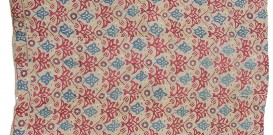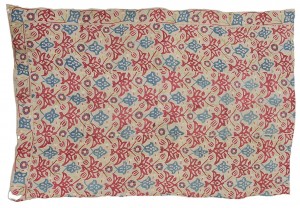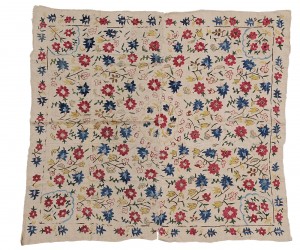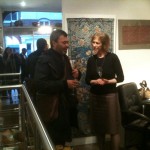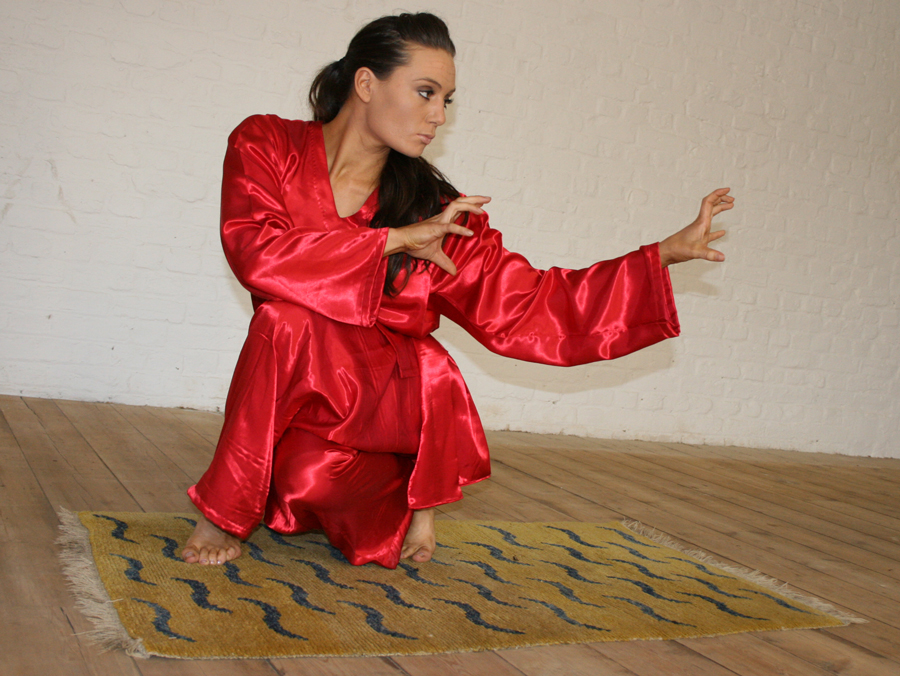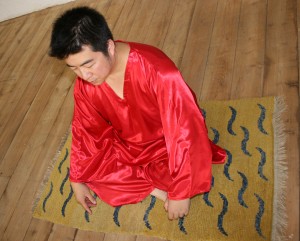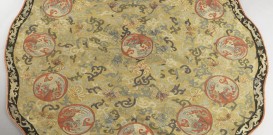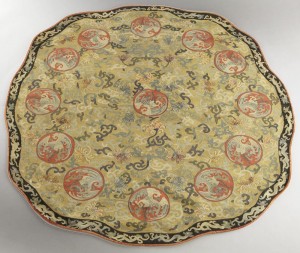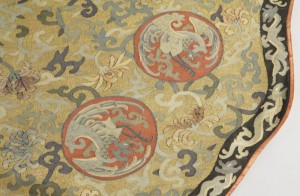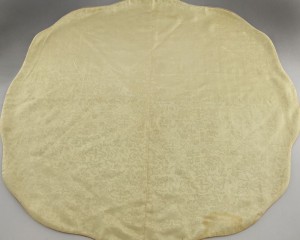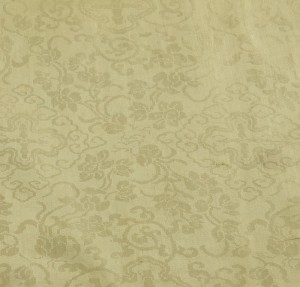Persian Rugs and Magic Carpets in Ancient Islamic Literature
Eastern Carpets and Persian Rugs turn up often in the book known as 1001 Nights, also known as Arabian Nights and 1001 Arabian Nights. 1001 nights is a collection of Middle Eastern and South Asian stories and folk tales compiled originally in Arabic during the Islamic Golden Age – which took place from around 750-1258 AD (or 750-1258 CE).
During the Islamic Golden Age, Eastern Kingdoms were known for fantastic ancient textiles, ceramics, glass, metalwork, eastern carpets, persian rugs, illuminate manuscripts, and intricate embroidery. The Eastern textile markets flourished, with spectacular persian rugs, tapestries, eastern carpets and wall-hangings from the region becoming very important as works of Art. Some of these ancient rugs and eastern textiles are still preserved today – at the Zadah gallery we have a considerable collection of Eastern Rugs, Persian Carpets and Eastern Textiles dating back to the Islamic Golden Age, with many from even before.
The stories in 1001 Nights can be traced back to ancient and mediaeval Arabic, Persian, Indian, Turkish and Mesopotamian folklore and literature – particularly Pahlavi Persian work (from the first milennium AD), which explains which persian carpets have a special place in many of the stories. The magic carpet, or flying carpet as it’s often known in the West, was brought to Western audiences through the stories of 1001 Arabian Nights. In our story below, taken from the collection of tales, the magic carpet of Tangu (also known as Prince Houssain’s Carpet) is a seemingly innocent Persian carpet, which turns out to have a spectacular magical ability. Even the Sultan of the Indies himself declares “I have a great many rarities in my museum already, but nothing that comes up to the carpet, the ivory tube, and the artificial apple, which shall have the first place among them, and shall be preserved carefully, not only for show, but to make an advantageous use of them upon all occasions.”
Our Eastern carpets and Persian Rugs in the Zadah gallery also have a magical quality, although they do not fly or transport you to places, anywhere but in your imagination. They have a timeless quality and an elegance that defies the hundreds of years since their manufacture by hand. That is why our clients and collectors find our antique Persian carpets and ancient Eastern rugs so desirable – they reflect a Golden Age, a time in history when the East led the world, producing fantastic discoveries in Art, Medicine, Philosophy, Mathematics and much more. Their timeless beauty reflects a bygone age of incredible achievements and fantastic ancient textiles and Art.
 Download your own copy of 1001 Arabian Nights for free
Download your own copy of 1001 Arabian Nights for free
The Tale of The Three Princes and the Princess Nouronnihar

 There was once a Sultan of India who had three sons. These, with the princess his niece, were the ornaments of his court. The eldest of the princes was called Houssain, the second Ali, the youngest Ahmed, and the princess his niece, Nouronnihar.
There was once a Sultan of India who had three sons. These, with the princess his niece, were the ornaments of his court. The eldest of the princes was called Houssain, the second Ali, the youngest Ahmed, and the princess his niece, Nouronnihar.
The Princess Nouronnihar was the daughter of the younger brother of the Sultan, to whom the Sultan in his lifetime allowed a considerable revenue. But that prince had not been married long before he died, and left the princess very young. The Sultan, out of brotherly love and friendship, took upon himself the care of his niece’s education, and brought her up in his palace with the three princes, where her singular beauty and personal accomplishments, joined to a sprightly disposition and irreproachable conduct, distinguished her among all the princesses of her time.
The Sultan, her uncle, proposed to get her married, when she arrived at a proper age, to some neighbouring prince, and was thinking seriously about it, when he perceived that the three princes his sons had all fallen in love with her. He was very much concerned, owing to the difficulty he foresaw whether the two younger would consent to yield to their elder brother. He spoke to each of them apart; and after having remonstrated on the impossibility of one princess being the wife of three persons, and the troubles they would create if they persisted, he did all he could to persuade them to abide by a declaration of the princess in favour of one of them; or to suffer her to be married to a foreign prince. But as he found them obstinate, he sent for them all together, and said to them, ‘Children, since I have not been able to persuade you no longer to aspire to marry the princess your cousin; and as I have no inclination to force her to marry any of you, I have thought of a plan which will please you all, and preserve union among you, if you will but follow my advice. I think it would be best, if every one travelled separately into a different country, so that you might not meet each other: and as you know I delight in every thing that is rare and singular, I promise my niece in marriage to him that shall bring me the most extraordinary curiosity; and for travelling expenses, I will give each of you a sum befitting your rank and the purchase of the curiosity you search.’
As the three princes were always submissive and obedient to the Sultan’s will, and each flattered himself that fortune would favour him, they all consented. The Sultan gave them the money he promised; and that very day they issued orders in preparation for their travels, and took leave of the Sultan, that they might be ready to set out early the next morning. They all went out at the same gate of the city, each dressed like a merchant, attended by a trusty officer dressed like a slave, all well mounted and equipped. They went the first day’s journey together; and slept at the first inn, where the road divided into three different tracks. At night when they were at supper together, they agreed to travel for a year, and to make that inn their rendezvous; that the first that came should wait for the rest; that as they had all three taken leave together of the sultan, they should all return together. The next morning by break of day, after they had embraced and wished each other good success, they mounted their horses, and each took a different road.
Prince Houssain, the eldest brother, who had heard wonders of the extent, strength, riches, and splendour of the kingdom of Bisnagar, bent his course towards the Indian coast; and, after three months travelling with different caravans, sometimes over deserts and barren mountains, and sometimes through populous and fertile countries, he arrived at Bisnagar, the capital of the kingdom of that name and the residence of its king. He lodged at a khan appointed for foreign merchants; and having learnt that there were four principal quarters where merchants of all sorts kept their shops, in the midst of which stood the castle, or rather the king’s palace, as the centre of the city, surrounded by three courts, and each gate two leagues distant from the other, he went to one of these quarters the next day.
Prince Houssain could not see this quarter without admiration. It was large, and divided into several streets, all vaulted and shaded from the sun, and yet very light. The shops were all of the same size and proportion; and all that dealt in the same sort of merchandise, as well as the craftsmen, lived in one street.
The multitude of shops stocked with the finest linens from several parts of India, some painted in the brightest colours, with men, landscapes, trees, and flowers; silks and brocades from Persia, China, and other places; porcelain from Japan and China, foot carpets of all sizes,–all this surprised him so much that he knew not how to believe his own eyes; but when he came to the shops of the goldsmiths and jewellers (for those two trades were exercised by the same merchants), he was dazzled by the lustre of the pearls, diamonds, rubies, emeralds, and other precious stones exposed for sale. But if he was amazed at seeing so many riches in one place, he was much more surprised when he came to judge of the wealth of the whole kingdom by considering that except the Brahmins and ministers of the idols, who profess a life retired from worldly vanity, there was not an Indian, man or woman, through the extent of that kingdom, who did not wear necklaces, bracelets, and ornaments about their legs and feet, made of pearls and other precious stones.
Another thing Prince Houssain particularly admired was the great number of rose-sellers, who crowded the streets; for the Indians are such lovers of that flower, that not one will stir without a nosegay in his hand, or a garland on his head; and the merchants keep them in pots in their shops, so that the air of the whole quarter, however large, is perfectly perfumed.
After Prince Houssain had run through the quarter, street by street, his thoughts fully occupied by the riches he had seen, he was very much tired, and a merchant civilly invited him to sit down in his shop. He accepted the offer; but had not been seated long before he saw a crier pass by with a piece of carpet on his arm, about six feet square, and cry it at thirty purses. The prince called to the crier, and asked to see the carpet, which seemed to him to be valued at an exorbitant price, not only for its size, but the meanness of the stuff. When he had examined it well, he told the crier that he could not comprehend how so small and poor a piece could be priced so high.
The crier, who took him for a merchant, replied, ‘Sir, if this price seems so extravagant to you, your amazement will be greater when I tell you I have orders to raise it to forty purses, and not to part with it for less.’
‘Certainly,’ answered Prince Houssain, ‘it must have something very extraordinary about it, which I know nothing of.’
‘You have guessed right, sir,’ replied the crier, ‘and will own as much when you come to know that whoever sits on this piece of carpet may be transported in an instant wherever he desires to go without being stopped by any obstacle.’
At this the Prince of the Indies, considering that the principal motive of his journey was to carry some singular curiosity home to the sultan his father, thought that be could not meet with anything which could give him more satisfaction. ‘If the carpet,’ said he to the crier, ‘has the virtue you assign it, I shall not think forty purses too much but shall make you a present besides.’
‘Sir,’ replied the crier, ‘I have told you the truth; and it will be an easy matter to convince you of it, as soon as you have made the bargain for forty purses, by experiment. But as I suppose you have not so much with you, and that I must go with you to the khan where you lodge, with the leave of the master of the shop we will go into his back shop, and I will spread the carpet; and when we have both sat down, and you have formed the wish to be transported into your room at the khan, if we are not transported thither it shall be no bargain. As to your present, as I am paid for my trouble by the seller, I shall receive it as a favour, and be very much obliged to you for it.’
The prince accepted the conditions, and concluded the bargain; and having obtained the master’s leave, they went into his back shop; they both sat down on the carpet, and as soon as the prince wished to be transported into his room at the khan, he found himself and the crier there, and as he wanted no more convincing proof of the virtue of the carpet, he counted to the crier forty purses of gold, and gave him twenty pieces for himself.
In this manner Prince Houssain became the possessor of the carpet, and was overjoyed that on his arrival at Bisnagar he had found so rare a treasure, which he never doubted would gain him the Princess Nouronnihar. In short he looked upon it as an impossible thing for the princes, his younger brothers, to meet with anything to compare with it. It was in his power, by sitting on this carpet, to be at the place of rendezvous that very day; but as he was obliged to wait for his brothers, as they had agreed, and as he was curious to see the King of Bisnagar and his court, and to learn about the laws, customs, and religion of the kingdom, he chose to make a longer abode there.
It was a custom of the King of Bisnagar to give audience to all strange merchants once a week; and Prince Houssain, who remained incognito, saw him often; and as he was handsome, clever, and extremely polite, he easily distinguished himself among the merchants, and was preferred before them all by the sultan, who asked him about the Sultan of the Indies, and the government, strength, and riches of his dominions.
The rest of his time the prince spent in seeing what was most remarkable in and about the city; and among other things he visited a temple, all built of brass. It was ten cubits square, and fifteen high; and the greatest ornament to it was an idol of the height of a man, of massy gold: its eyes were two rubies, set so artificially, that it seemed to look at those who looked at it, on whichever side they turned. Besides this, there was another not less curious, in a village in the midst of a plain of about ten acres, which was a delicious garden full of roses and the choicest flowers, surrounded with a small wall breast high, to keep the cattle out. In the midst of this plain was raised a terrace, a man’s height, so nicely paved that the whole pavement seemed to be but one single stone. A temple was erected in the middle of this terrace, with a dome about fifty cubits high, which might be seen for several leagues round. It was thirty cubits long, and twenty broad, built of red marble, highly polished. The inside of the dome was adorned with three rows of fine paintings, in good taste: and there was not a place in the whole temple but was embellished with paintings, bas-reliefs, and figures of idols from top to bottom.
Every night and morning there were ceremonies performed in this temple, which were always succeeded by sports, concerts, dancing, singing, and feasts. The ministers of the temple and the inhabitants of the place had nothing to live on but the offerings of pilgrims, who came in crowds from the most distant parts of the kingdom to perform their vows.
Prince Houssain was also spectator of a solemn feast, which was celebrated every year at the court of Bisnagar, at which all the governors of provinces, commanders of fortified places, all the governors and judges of towns, and the Brahmins most celebrated for their learning, were obliged to be present; and some lived so far off that they were four months in coming. This assembly, composed of innumerable multitudes of Indians, met in a plain of vast extent, as far as the eye could reach. In the centre of this plain was a square of great length and breadth, closed on one side by a large scaffolding of nine stories, supported by forty pillars, raised for the king and his court, and those strangers whom he admitted to audience once a week. Inside, it was adorned and furnished magnificently; and on the outside were painted fine landscapes, wherein all sorts of beasts, birds, and insects, even flies and gnats, were drawn as naturally as possible. Other scaffolds of at least four or five stories, and painted almost all alike, formed the other three sides.
On each side of the square, at some little distance from each other, were ranged a thousand elephants, sumptuously harnessed, each having upon his back a square wooden castle, finely gilt, in which were musicians and actors. The trunks, ears, and bodies of these elephants were painted with cinnabar and other colours, representing grotesque figures.
But what Prince Houssain most of all admired was to see the largest of these elephants stand with his four feet on a post fixed into the earth, two feet high, playing and beating time with his trunk to the music. Besides this, he admired another elephant as big, standing on a board, which was laid across a strong beam about ten feet high, with a great weight at the other end which balanced him, while he kept time with the music by the motions of his body and trunk.
Prince Houssain might have made a longer stay in the kingdom and court of Bisnagar, where he would have seen other wonders, till the last day of the year, whereon he and his brothers had appointed to meet. But he was so well satisfied with what he had seen, and his thoughts ran so much upon the Princess Nouronnihar, that he fancied he should be the more easy and happy the nearer he was to her. After he had paid the master of the khan for his apartment, and told him the hour when he might come for the key, without telling him how he should go, he shut the door, put the key on the outside, and spreading the carpet, he and the officer he had brought with him sat down on it, and, as soon as he had wished, were transported to the inn at which he and his brothers were to meet, where he passed for a merchant till they came.
Prince Ali, the second brother, travelled into Persia with a caravan, and after four months’ travelling arrived at Schiraz, which was then the capital of the kingdom of Persia, and having on the way made friends with some merchants, passed for a jeweller, and lodged in the same khan with them.
The next morning, while the merchants were opening their bales of merchandise, Prince Ali took a walk into that quarter of the town where they sold precious stones, gold and silver work, brocades, silks, fine linens, and other choice and valuable merchandise, which was at Schiraz called the bezestein. It was a spacious and well-built place, arched over, and supported by large pillars; along the walls, within and without, were shops. Prince Ali soon rambled through the bezestein, and with admiration judged of the riches of the place by the prodigious quantities of most precious merchandise there exposed to view.
But among all the criers who passed backwards and forwards with several sorts of things to sell, he was not a little surprised to see one who held in his hand an ivory tube about a foot in length and about an inch thick, and cried it at thirty purses. At first he thought the crier mad, and to make sure, went to a shop, and said to the merchant, who stood at the door, ‘Pray, sir, is not that man mad? If he is not, I am very much deceived.’
‘Indeed, sir,’ answered the merchant, ‘he was in his right senses yesterday, and I can assure you he is one of the ablest criers we have, and the most employed of any when anything valuable is to be sold; and if he cries the ivory tube at thirty purses, it must be worth as much, or more, for some reason or other which does not appear. He will come by presently, and we will call him; in the meantime sit down on my sofa and rest yourself.’
Prince Ali accepted the merchant’s obliging offer, and presently the crier passed by. The merchant called him by his name; and pointing to the prince, said to him, ‘Tell that gentleman, who asked me if you were in your right senses, what you mean by crying that ivory tube, which seems not to be worth much, at thirty purses: I should be very much amazed myself, if I did not know you were a sensible man.’
The crier, addressing himself to Prince Ali, said, ‘Sir, you are not the only person that takes me for a madman on account of this tube; you shall judge yourself whether I am or no, when I have told you its peculiarity. First, sir,’ pursued the crier, presenting the ivory tube to the prince, ‘observe that this tube is furnished with a glass at both ends; by looking through one of them you see whatever object you wish to behold.’
‘I am,’ said the prince, ‘ready to make you all proper reparation for the scandal I have thrown on you, if you will make the truth of what you say appear’; and as he had the ivory tube in his hand, he said, ‘Show me at which of these ends I must look.’ The crier showed him, and he looked through, wishing at the same time to see the sultan, his father. He immediately beheld him in perfect health, sitting on his throne, in the midst of his council. Afterwards, as there was nothing in the world so dear to him, after the sultan, as the Princess Nouronnihar, he wished to see her, and saw her laughing, and in a pleasant humour, with her women about her.
Prince Ali needed no other proof to persuade him that this tube was the most valuable thing, not only in the city of Schiraz, but in all the world; and he believed that, if he should neglect it, he would never meet again with such another rarity. He said to the crier, ‘I am very sorry that I should have entertained so bad an opinion of you, but hope to make you amends by buying the tube, so tell me the lowest price the seller has fixed upon it. Come with me, and I will pay you the money.’ The crier assured him that his last orders were to take no less than forty purses; and, if he disputed the truth of what he said, he would take him to his employer. The prince believed him, took him to the khan where he lodged, counted out the money, and received the tube.
Prince Ali was overjoyed at his bargain; and persuaded himself that, as his brothers would not be able to meet with anything so rare and marvellous, the Princess Nouronnihar would be his wife. He thought now of visiting the court of Persia incognito, and seeing whatever was curious in and about Schiraz, till the caravan with which he came returned back to the Indies. When the caravan was ready to set out, the prince joined them, and arrived without any accident or trouble at the place of rendezvous, where he found Prince Houssain, and both waited for Prince Ahmed.
Prince Ahmed took the road to Samarcand; and the day after his arrival there went, as his brothers had done, into the bezestein. He had not walked long before he heard a crier, who had an artificial apple in his hand, cry it at five-and-thirty purses. He stopped the crier, and said to him, ‘Let me see that apple, and tell me what virtue or extraordinary property it has, to be valued at so high a rate.’
‘Sir,’ said the crier, putting it into his hand, ‘if you look at the outside of this apple, it is very ordinary; but if you consider the great use and benefit it is to mankind, you will say it is invaluable. He who possesses it is master of a great treasure. It cures all sick persons of the most mortal diseases, fever, pleurisy, plague, or other malignant distempers; and, if the patient is dying, it will immediately restore him to perfect health; and this is done after the easiest manner in the world, merely by the patient smelling the apple.’
‘If one may believe you,’ replied Prince Ahmed, ‘the virtues of this apple are wonderful, and it is indeed valuable: but what ground has a plain man like myself, who may wish to become the purchaser, to be persuaded that there is no deception or exaggeration in the high praise you bestow on it?’
‘Sir,’ replied the crier, ‘the thing is known and averred by the whole city of Samarcand; but, without going any further, ask all these merchants you see here, and hear what they say; several of them would not have been alive this day if they had not made use of this excellent remedy. It is the result of the study and experience of a celebrated philosopher of this city, who applied himself all his life to the knowledge of plants and minerals, and at last performed such surprising cures in this city as will never be forgotten; but he died suddenly himself, before he could apply his own sovereign remedy, and left his wife and a great many young children behind him in very indifferent circumstances; to support her family, and provide for her children, she has resolved to sell it.’
While the crier was telling Prince Ahmed the virtues of the artificial apple, a great many persons came about them, and confirmed what he said; and one among the rest said he had a friend dangerously ill, whose life was despaired of, which was a favourable opportunity to show Prince Ahmed the experiment. Upon which Prince Ahmed told the crier he would give him forty purses if he cured the sick person by letting him smell at it.
The crier, who had orders to sell it at that price, said to Prince Ahmed, ‘Come, sir, let us go and make the experiment, and the apple shall be yours; it is an undoubted fact that it will always have the same effect as it already has had in recovering from death many sick persons whose life was despaired of.’
The experiment succeeded, and the prince, after he had counted out to the crier forty purses, and the other had delivered the apple to him, waited with the greatest impatience for the first caravan that should return to the Indies. In the meantime he saw all that was curious in and about Samarcand, especially the valley of Sogda, so called from the river which waters it, and is reckoned by the Arabians to be one of the four paradises of this world, for the beauty of its fields and gardens and fine palaces, and for its fertility in fruit of all sorts, and all the other pleasures enjoyed there in the fine season.
At last Prince Ahmed joined the first caravan that returned to the Indies, and arrived in perfect health at the inn where the Princes Houssain and Ali were waiting for him.
Prince Ali, who was there some time before Prince Ahmed, asked Prince Houssain, who got there first, how long he had been there; he told him three months: to which he replied, ‘Then certainly you have not been very far.’
‘I will tell you nothing now,’ said Prince Houssain, ‘but only assure you I was more than three months travelling to the place I went to.’
‘But then,’ replied Prince Ali, ‘you made a short stay there.’
‘Indeed, brother,’ said Prince Houssain, ‘you are mistaken: I resided at one place over four or five months, and might have stayed longer.’
‘Unless you flew back,’ replied Prince Ali again, ‘I cannot comprehend how you can have been three months here, as you would make me believe.’
‘I tell you the truth,’ added Prince Houssain, ‘and it is a riddle which I shall not explain till our brother Ahmed comes; then I will let you know what curiosity I have brought home from my travels. I know not what you have got, but believe it to be some trifle, because I do not see that your baggage is increased.’
‘And pray what have you brought?’ replied Prince Ali, ‘for I can see nothing but an ordinary piece of carpet, with which you cover your sofa, and as you seem to make what you have brought a secret, you cannot take it amiss that I do the same.’
‘I consider the rarity which I have purchased,’ replied Prince Houssain, ‘to excel all others whatever, and should not have any objection to show it you, and make you agree that it is so, and at the same time tell you how I came by it, without being in the least apprehensive that what you have got is better. But we ought to wait till our brother Ahmed arrives, that we may all communicate our good fortune to each other.’
Prince Ali would not enter into a dispute with Prince Houssain, but was persuaded that, if his perspective glass were not preferable, it was impossible it should be inferior, and therefore agreed to wait till Prince Ahmed arrived, to produce his purchase.
When Prince Ahmed came, they embraced and complimented each other on the happiness of meeting together at the place they set out from. Then Prince Houssain, as the elder brother, said, ‘Brothers, we shall have time enough hereafter to entertain ourselves with the particulars of our travels: let us come to that which is of the greatest importance for us to know; let us not conceal from each other the curiosities we have brought home, but show them, that we may do ourselves justice beforehand and see to which of us the sultan our father may give the preference.
‘To set the example,’ continued Prince Houssain, ‘I will tell you that the rarity which I have brought from my travels to the kingdom of Bisnagar, is the carpet on which I sit, which looks but ordinary and makes no show; but, when I have declared its virtues to you, you will be struck with admiration, and will confess you never heard of anything like it. Whoever sits on it as we do, and desires to be transported to any place, be it ever so far off, is immediately carried thither. I made the experiment myself before I paid down the forty purses, and when I had fully satisfied my curiosity at the court of Bisnagar, and had a mind to return, I made use of no other means than this wonderful carpet for myself and servant, who can tell you how long we were coming hither. I will show you both the experiment whenever you please. I expect you to tell me whether what you have brought is to be compared to this carpet.’
Here Prince Houssain ended, and Prince Ali said, ‘I must own, brother, that your carpet is one of the most surprising things imaginable, if it has, as I do not doubt in the least, that property you speak of. But you must allow that there may be other things, I will not say more, but at least as wonderful, in another way; and to convince you there are, here is an ivory tube, which appears to the eye no more a rarity than your carpet. It cost me as much, and I am as well satisfied with my purchase as you can be with yours; and you will be so just as to own that I have not been cheated, when you know by experience that by looking at one end you see whatever you wish to behold. Take it,’ added Prince Ali, presenting the tube to him, ‘make trial of it yourself.’
Prince Houssain took the ivory tube from Prince Ali, and clapped that end to his eye which Prince Ali showed him, to see the Princess Nouronnihar, and to know how she was, when Prince Ali and Prince Ahmed, who kept their eyes fixed upon him, were extremely surprised to see his countenance change suddenly with extraordinary pain and grief. Prince Houssain would not give them time to ask what was the matter, but cried out, ‘Alas! princes, to what purpose have we undertaken long and fatiguing journeys? In a few moments our lovely princess will breathe her last. I saw her in her bed, surrounded by her women and attendants, who were all in tears. Take the tube, behold for yourselves the miserable state she is in.’
Prince Ali took the tube out of Prince Houssain’s hand and after he had looked, presented it to Prince Ahmed.
When Prince Ahmed saw that the Princess Nouronnihar’s end was so near, he addressed himself to his two brothers, and said, ‘Princes, the Princess Nouronnihar, the object of all our vows, is indeed at death’s door; but provided we make haste and lose no time, we may preserve her life.’ Then he took out the artificial apple, and showing it to the princes his brothers, said to them, ‘This apple which you see here cost as much as either the carpet or tube. The opportunity now presents itself to show you its wonderful virtue. Not to keep you longer in suspense, if a sick person smells it, though in the last agonies, it restores him to perfect health immediately. I have made the experiment, and can show you its wonderful effect on the Princess Nouronnihar, if we make all haste to assist her.’
‘If that is all,’ replied Prince Houssain, ‘we cannot make more haste than by transporting ourselves instantly into her room by the means of my carpet. Come, lose no time; sit down on it by me; it is large enough to hold us all three: but first let us give orders to our servants to set out immediately, and join us at the palace.’
As soon as the order was given, Prince Ali and Prince Ahmed went and sat down by Prince Houssain, and all three framed the same wish, and were transported into the Princess Nouronnihar’s chamber.
The presence of the three princes, who were so little expected, frightened the princess’s women and attendants, who could not comprehend by what enchantment three men should be among them; for they did not know them at first, and the attendants were ready to fall upon them, as people who had got into a part of the palace where they were not allowed to come; but they presently recollected and found their mistake.
Prince Ahmed no sooner saw himself in Nouronnihar’s room, and perceived the princess dying, than he rose off the tapestry, as did also the other two princes, and went to the bed-side, and put the apple under her nose. Some moments after, the princess opened her eyes, and turned her head from one side to another, looking at the persons who stood about her; she then rose up in the bed, and asked to be dressed, just as if she had awaked out of a sound sleep. Her women informed her, in a manner that showed their joy, that she was obliged to the three princes her cousins, and particularly to Prince Ahmed, for the sudden recovery of her health. She immediately expressed her joy to see them, and thanked them all together, and afterwards Prince Ahmed in particular, and they then retired.
While the princess was dressing, the princes went to throw themselves at the Sultan their father’s feet, and pay their respects to him. The Sultan received and embraced them with the greatest joy, both for their return and for the wonderful recovery of the princess his niece, whom he loved as if she had been his own daughter, and who had been given over by the physicians. After the usual compliments, the princes presented each the curiosity which he had brought: Prince Houssain his carpet, which he had taken care not to leave behind him in the princess’s chamber; Prince Ali his ivory tube, and Prince Ahmed the artificial apple; and after each had commended his present, when they put it into the Sultan’s hands, they begged him to pronounce their fate, and declare to which of them he would give the Princess Nouronnihar for a wife, according to his promise.
The Sultan of the Indies having kindly heard all that the princes had to say, without interrupting them, and being well informed of what had happened in relation to the Princess Nouronnihar’s cure, remained some time silent, as if he were thinking what answer he should make. At last he broke silence, and said to them in terms full of wisdom, ‘I would declare for one of you, my children, with a great deal of pleasure, if I could do so with justice; but consider whether I can. It is true, Prince Ahmed, the princess my niece is obliged to your artificial apple for her cure, but let me ask you, whether you could have been so serviceable to her if you had not known by Prince Ali’s tube the danger she was in, and if Prince Houssain’s carpet had not brought you to her so soon?
‘Your tube, Prince Ali, informed you and your brothers that you were likely to lose the princess your cousin, and so far she is greatly obliged to you. You must also grant that that knowledge would have been of no service without the artificial apple and the carpet.
‘And for you, Prince Houssain, consider that it would have been of little use if you had not been acquainted with the princess’s illness by Prince Ali’s tube, and Prince Ahmed had not applied his artificial apple. Therefore, as neither the carpet, the ivory tube, nor the artificial apple has the least preference one over the other, but, on the contrary, there is a perfect equality, I cannot grant the princess to any one of you, and the only fruit you have reaped from your travels is the glory of having equally contributed to restore her to health.
‘If this be true,’ added the Sultan, ‘you see that I must have recourse to other means to determine with certainty in the choice I ought to make among you, and as there is time enough between this and night, I will do it to-day. Go, and get each of you a bow and arrow, and repair to the great plain outside the city, where the horses are exercised. I will soon come to you, and I declare I will give the Princess Nouronnihar to him that shoots the farthest.
‘I do not, however, forget to thank you all in general, and each in particular, for the presents you brought me. I have a great many rarities in my museum already, but nothing that comes up to the carpet, the ivory tube, and the artificial apple, which shall have the first place among them, and shall be preserved carefully, not only for show, but to make an advantageous use of them upon all occasions.’
The three princes had nothing to say against the decision of the sultan. When they were out of his presence, they each provided themselves with a bow and arrow, which they delivered to one of their officers, and went to the plain appointed, followed by a great concourse of people.
The sultan did not make them wait long; and as soon as he arrived, Prince Houssain, as the eldest, took his bow and arrow, and shot first. Prince Ali shot next, and much beyond him; and Prince Ahmed last of all; but it so happened, that nobody could see where his arrow fell; and, notwithstanding all the search of himself and everybody else, it was not to be found far or near. And though it was believed that he shot the farthest, and that he therefore deserved the Princess Nouronnihar, it was necessary that his arrow should be found, to make the matter evident and certain; so, notwithstanding his remonstrances, the sultan determined in favour of Prince Ali, and gave orders for preparations to be made for the wedding, which was celebrated a few days afterwards with great magnificence.
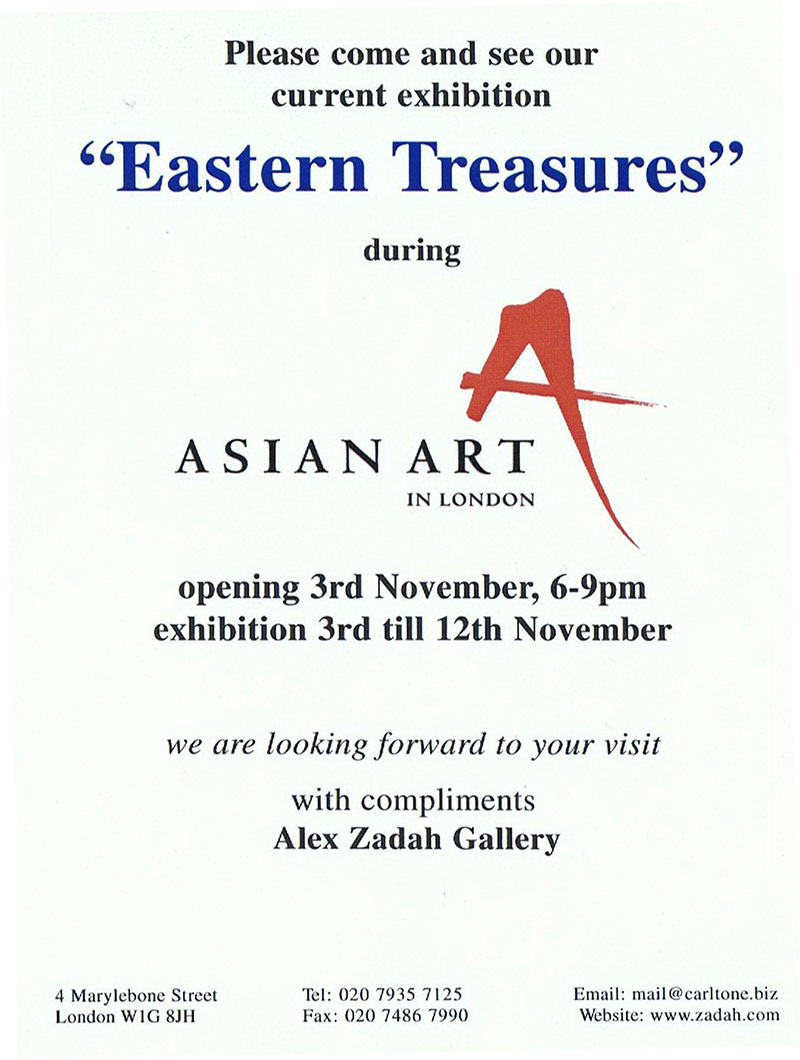
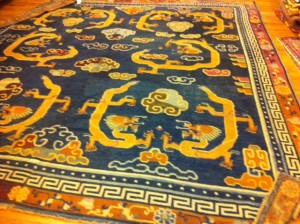 “During my trip to the USA, I chanced upon this fantastic piece – a 19th Century Antique Tibetan Carpet. Interestingly, the Dragons are all large – 3 or 4 frets long. It’s very rare to see this type of work – it’s a speciality – this particular Tibetan carpet has been made in 2 pieces, in 2 separate looms, which were then brought together at a later date to complete the Tibetan carpet.”
“During my trip to the USA, I chanced upon this fantastic piece – a 19th Century Antique Tibetan Carpet. Interestingly, the Dragons are all large – 3 or 4 frets long. It’s very rare to see this type of work – it’s a speciality – this particular Tibetan carpet has been made in 2 pieces, in 2 separate looms, which were then brought together at a later date to complete the Tibetan carpet.”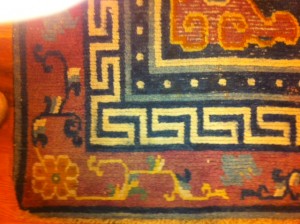 Dragons are one of the more popular designs on antique Tibetan carpets, as the Dragon is a good luck symbol in Tibetan folklore – Tibetans consider the Dragon to be a benevolent being, bringing goodwill to mankind. This is in sharp contrast to the way ancient Western culture portrays the Dragon – in George and the Dragon, for example.
Dragons are one of the more popular designs on antique Tibetan carpets, as the Dragon is a good luck symbol in Tibetan folklore – Tibetans consider the Dragon to be a benevolent being, bringing goodwill to mankind. This is in sharp contrast to the way ancient Western culture portrays the Dragon – in George and the Dragon, for example.
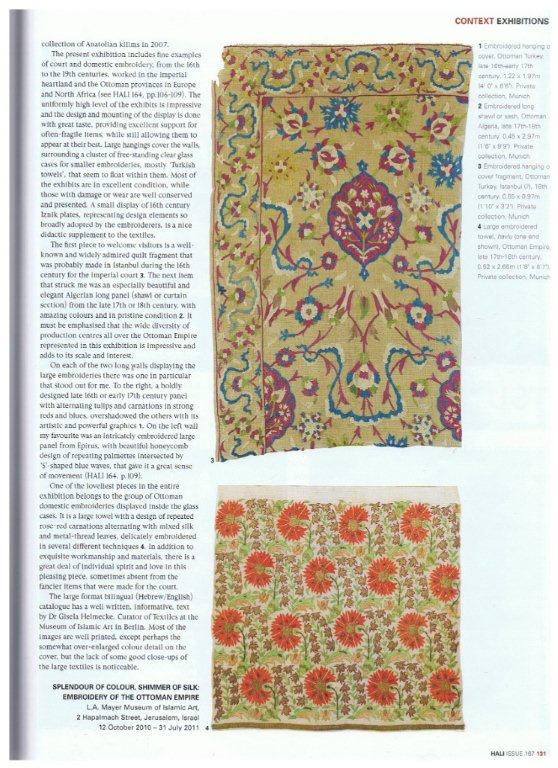
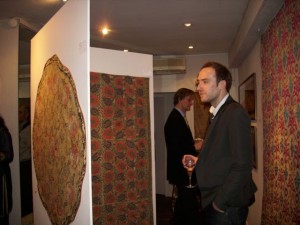 Containing Antique Carpets and Rugs, and Antique Textiles, Zadah Gallery’s latest exhibition features a selection of very rare, highly collectable, museum-quality antique rugs and textiles from historical Dynasties such as Ming and Mughul.
Containing Antique Carpets and Rugs, and Antique Textiles, Zadah Gallery’s latest exhibition features a selection of very rare, highly collectable, museum-quality antique rugs and textiles from historical Dynasties such as Ming and Mughul. The evening was a resounding success, and the guests enjoyed champagne and sushi canapes, whilst marveling at the intricacy of the textiles and craftsmanship ranging from the 16th to 19th Century. These include the Ottoman, Ming Dynasty and Mughal periods.
The evening was a resounding success, and the guests enjoyed champagne and sushi canapes, whilst marveling at the intricacy of the textiles and craftsmanship ranging from the 16th to 19th Century. These include the Ottoman, Ming Dynasty and Mughal periods.
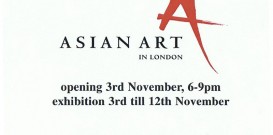
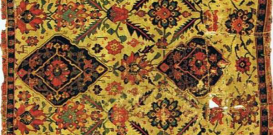
 Download your own copy of 1001 Arabian Nights for free
Download your own copy of 1001 Arabian Nights for free
 There was once a Sultan of India who had three sons. These, with the princess his niece, were the ornaments of his court. The eldest of the princes was called Houssain, the second Ali, the youngest Ahmed, and the princess his niece, Nouronnihar.
There was once a Sultan of India who had three sons. These, with the princess his niece, were the ornaments of his court. The eldest of the princes was called Houssain, the second Ali, the youngest Ahmed, and the princess his niece, Nouronnihar.